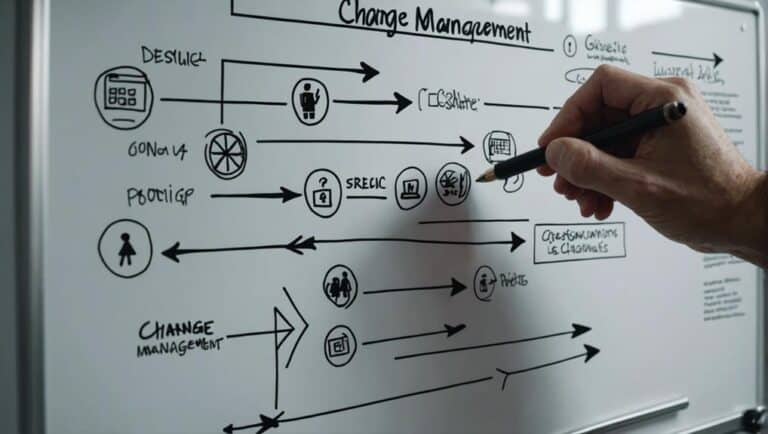What makes a transition successful? Change management is a detailed process, meaning it has many moving parts and aspects to manage. In this article, we’ll walk you through the most critical element of change management and other vital components that make the process successful.
Communication is the most critical aspect of change management. Change managers must communicate their plan, the need for change, and the end goal to the organization’s stakeholders, managers, and employees. Clear communication before, during, and after the transition, combined with other aspects, ensures success.
It’s true that most people don’t like change. However, the reality is that we live in a rapidly evolving digital world where change is inevitable.
Whether an organization likes it or not, it will be forced to make transitions like implementing new technology or introducing a new department, and it’s up to the senior managers to adapt in the most efficient way possible.
Let’s explore key components of change, including communication.
Why is Communication the Most Important Aspect of Change Management?
Even in normal circumstances, communication is a challenge for many organizations. When it comes to times of transition, it becomes crucial to success. According to a study by Kotter, over 30% of change initiatives fail. Bad communication plans are one reason the best change management processes go bad.
A carefully crafted and executed communication plan can ensure a smoother transition. Companies must be careful with who delivers what message and when during a transitional period, poor communication skills can result in a shift towards a negative organizational culture.
Developing a strategic communication plan for a change can be long and tedious. Still, it will ensure that managers, stakeholders, and employees have all the information they need to achieve their milestones in time and successfully.
The 4 Stages of a Communication Plan for Change
Communication isn’t a one-and-done thing when it comes to the change management process, it has to be constant during the key stages of a process to ensure the message hits home and there is clarity in what needs to be done and by who.
Let’s look at four key stages during a transition where communication is critical for milestone completion and moving forward.

Awareness Stage
This is the introductory stage where you will slowly introduce the idea of a change across the different levels of the organization. Your strategy at this stage is to promote the idea that change is healthy by listing its positives for the hierarchy in the organization.
Understanding Stage
This goes a little deeper in preparing the employees to embrace the change. You can anticipate what can go wrong and then prepare teams and individuals accordingly. This stage focuses on letting the idea of change seep into the minds and preparing for any setbacks without things turning toxic.
Acceptance Stage
Employees must embrace change and let go of their anxiety. You need to empower your employees to give feedback and communicate freely during the process. This will help them accept change and let go of their fears.
Ownership Stage
The last stage or level of the process is when employees begin to own the process and the change. Giving them credit and praise at every successful milestone and making them realize that it is through their efforts that the implementation is going strong will create a sense of ownership in them.
This is great for implementing changes in the future because now they have been through the process before.
Tips for Communicating Effectively For Change Management
Now that we know the different stages of communication that are necessary, let’s look at some tips for effective communication during transitions. Effective communication is an art, and there are several steps and initiatives that you can take to succeed at it.
1. Stay Consistent
Communication during transition has to be constant. Change managers must communicate updates and changes with everyone in the organization regularly. The fear of the unknown and anxiety related to job security can make employees resistant to change. They need to be constantly reminded why change is necessary and what value it brings to them and the organization.
2. Focus on the “Why”
Besides being consistent in communication, take the ambiguity out of the process by regularly communicating why change is necessary. As discussed above, this communication must be especially strong during the “awareness” stage.
You can identify sponsors during this stage. Later on, these sponsors can help you identify or predict any resistant behaviors that their fellow employees can show during implementation.
This is an excellent way of staying proactive and battling resistance before it becomes apparent.
3. Communicate through multiple channels
Communication can happen through different channels, and that’s a blessing because every employee will have a different way of receiving and understanding information. It’s best not to rely on one channel of communication. You can:
- Send regular emails or newsletters
- Create videos
- Hold meetings and training sessions
- Chat in person

You can also utilize your change management or project management tool and the communication channels that come with it, like campaign managers. These tools allow you to send timed emails with video and image attachments that can help reinforce the message.
4. Show flexibility to feedback
The process for transition should be flexible. Employees often feel neglected and frustrated when their feedback isn’t taken seriously or implemented. As a change manager, you can take this frustration away by simply being flexible and adjusting your process to incorporate good feedback.
External factors can also change your process’s course and should not be ignored. Using tools like social media surveys to interact with your customers and get feedback is always best. This feedback is also valuable when you are changing how you do things because customers and vendors are often affected by changes made to an organization.
5. Prioritize honesty
Maintaining your credibility is crucial if you want employees and stakeholders to trust you. When relaying information, it is best to stay honest and do the best of your abilities. If you don’t have an answer, say that you will respond after doing your research.
Exaggerating or giving wrong information can hurt your credibility and the overall process. Being open to communication and staying honest is your best weapon as a change maker.
6. Keep progress reports public
Employees put a lot of effort into achieving their milestones during a change management process. Transitions are a journey, and everyone must be regularly updated on where they are on the journey and how long before they reach their destination.
People like to feel in control, and regular updates and information give them that control. There is a reason why we say that knowledge is power.
Use your project management tools to keep the entire organization updated with progress and appreciate teams and employees when a milestone is achieved.
Including these six tips in your change management plan will help you develop a robust roadmap for navigating through unexpected situations.
What Are Other Aspects of Change Management?
Now that we have covered the most crucial aspect of the process in detail above, it is worth looking at the other aspects that work with communication to ensure successful change management.
1. Change Impact Analysis
One of the first steps you’re going to take is to run an impact assessment. This will involve looking at all the aspects involved in the process. You will:
- Lock the extent and dynamics of the change by comparing the organization’s current and desired state.
- Determine the impact of the change and then lock down the requirements to achieve it.
- Prioritizing the requirements according to the impact.
- Decision-making based on this priority setting.
2. Convincing Stakeholders
Getting stakeholder buy-in is absolutely crucial, and something a transition’s success depends on. Change must happen from the top. Employees must be convinced that the business leaders are serious about the process and are embracing it like they want them to embrace it.
Change requires time and money, and this investment will come with the help of the key stakeholders. This begins with convincing stakeholders with data points that will show the positive outcome of change and why it is needed.
You can build a team of sponsors within the organization who will be your advocates and will show visible buy-in to other employees and stakeholders. You cannot lead the entire initiative on your own, so it is important to have this team in different departments and levels to be the mouthpieces of change.
3. Engage The Team
What is the best way to combat resistance? Early and consistent involvement. Change is scary. People feel uncertain in the face of anything new, which is why employees resist change.
The key is good communication and involving people as soon as possible after you get the go-ahead to implement the change. Start by introducing small changes and switching out more minor parts of existing processes to ease people into the change.
The way change is managed will depend on the organizational structure and the nature of the team implementing it. Based on these factors, change can be led by the executive team or the technical team.
In both cases, the other will act as a supporting factor to keep engagement levels high and to drive decision-making by eliminating blockers.
4. Combat Cultural Tension
According to a Gartner research, 80% of employees go through a cycle of cultural tension during change. This tension can result from competing priorities like quality vs. speed, people vs. profits, innovation vs. efficiency etc.
Your change management process should be handled in a way that represents the new norms and culture you want to see within your organization instead of what is already happening. Otherwise, there is no real benefit from putting your employees through the entire transition process.
5. Develop a Resistance Management Plan
There is not a single change management process where resistance will be nil. It is natural for employees to feel anxious and fearful when the organization or their team goes through a transition.
Your job is to combat this resistance with the proper processes and tools in place. Plan ahead to manage the human side of the process. Here is what you can do:
- Work on proactive strategies, address areas where you think you will experience the most resistance, and eliminate resistance early in the process.
- Have a plan to manage resistance as it happens
- Celebrate small wins to show appreciation to employees. This will help them feel at ease and reduce their resistance and negative feelings.
6. Stay Flexible
Like the Agile development process, a good change management strategy always accounts for evolution and iteration. Transitions aren’t quick one-and-done processes; they are a long journey. You need to be flexible to changing circumstances.
It is imperative that everyone has access to all the information, KPIs and progress, so it is easy to determine the rate of success and any changes that need to be made.
Being able to pivot as needed is the mark of a good change-maker and a flexible transition plan. Utilize data at every stage to predict the flow of work and the process and make changes as necessary and proactively.
Frequently Asked Questions
What is the role of communication in continuous improvement?
Communication is crucial for improvement initiatives. It visualizes goals and the overall approach for the employees.
It’s the best tool to motivate people to commit to change as it shows them the benefits it brings to them and the organization.
However, it is essential to remember that too much or wrong information can harm the process more than do good.
Why is communication constant?
A company can only survive and thrive with engaged staff who understand the business goals. The best way to keep staff informed is by communicating with them regularly. This helps build trust between the two parties.
Communication is a constant process; it should be part of the status quo. Every communication will require more follow on communication, so the process is ongoing.
What are the four steps of communicating organizational change?
The four steps include sharing a vision, telling a story, nominating sponsors, and charting the path for change. Each step needs to be executed carefully to get the buy-in from stakeholders and employees alike.
What Are the Key Components of Successful Change Management Implementation?
Successful implementing change management organization involves clear communication, strong leadership, and employee participation. It also requires a thorough analysis of the current state, a well-defined roadmap for change, and a supportive organizational culture. These key components are crucial for a smooth and effective change management process.
Final Thoughts
Any transition within an organization relies heavily on effective communication and buy-in. Communication needs to be strategically planned and proactively executed for successful results. Communication alone cannot ensure success, so we hope you pay attention to the other aspects outlined above for a smooth transition.
Sources
https://link.springer.com/referenceworkentry/10.1007%2F978-3-319-49820-1_47-1
https://www.gartner.com/smarterwithgartner/resolve-cultural-tensions-at-work





